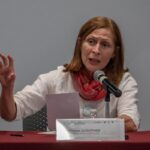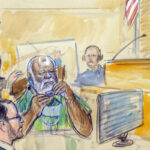You’d think that Mary McCartney — the eldest child of Paul and Linda McCartney, and the director the new Abbey Road Studios documentary If These Walls Could Sing — would bring up her father when asked about her earliest memories of the hallowed Abbey Road space. But instead, she brings up another British pop icon that, against all odds, she convinced to participate in the film: Kate Bush.
“I think my first sort of memory [of Abbey Road] is walking into the reception area when I was a little kid, probably like 6 or 7,” Mary recalls. “The reception area there used to have photographs of all of the musicians that had been there before, this beautiful gallery of pictures. And there was Kate Bush… I really remember seeing that picture.”
[embedded content]
Mary reached out to Bush well before the reclusive songstress’s 37-year-old Hounds of Love single, “Running Up That Hill,” became a surprise 2022 hit thanks to Stranger Things. Mary already believed that Kate “was very important to include in the film, because she produced her own music there. She directed her own music documentaries. She was an incredible talent that utilized Abbey Road so well.
“I texted her and said, ‘Would you mind… could I speak to you? I’m directing this documentary — could we speak?’ I was quite nervous,” Mary confesses. “And she was like, ‘Oh, thank you, but you know I don’t do interviews.’ … Well, I knew that she doesn’t do on-camera interviews, so I sort of stayed in touch with her. … Eventually I just said, ‘Look, it’s so important to have you included. Would you even just sort of record something [as audio only] and send it?’ And hat’s what she ended up doing. I heard it, and I got chills. … I literally couldn’t believe my luck. It is one of the highlights of my life, getting to know Kate and being able to speak to her about her history there.”
[embedded content]
Obviously, Bush’s fortuitous inclusion could not have been more timely. But as Mary set out to illustrate that Abbey Road Studios was more than just the Beatles’ sacred space, another artist’s “upsetting” appearance in If These Walls Could Sing turned out to be not quite so well-timed. The film features several minutes of archival 2006 footage of Ye, then known as Kanye West, at Abbey Road with a 17-piece all-female string ensemble, working on his live album Late Orchestration. Mary stresses that she did not actually interview the notorious rapper or shoot any new footage of him, and that by the time Ye had made his most egregious antisemitic comments, it was too late even contemplate editing his segment out of the documentary.
“It’s upsetting, because any kind of antisemitism or racism is something that really is very upsetting to me, and to most everybody else. The interview [in the film] is a really vintage interview that was done at the time of him recording there a long time ago,” Mary sighs. “Including him that in the process, when I was making the documentary, was to include all the different range of artists that have been there utilizing that space. And, you know, it was a great album that he recorded there. … But the documentary had already been locked. Then lot of his press interviews that he’s been doing started to come about. It’s quite upsetting.”
[embedded content]
Among the new interviews that Mary conducted for the film were Oasis’s Gallagher brothers — separately, of course. She may have been able to convince Kate Bush to record some original narration, but getting Liam and Noel in the same room was always going to be even more of a long-shot. (“I can only do my best!” Mary laughs.) However, she found her conversations with two other rock legends to be especially illuminating.
“I had no idea that Elton John and Jimmy Page had been session musicians there!” Mary marvels. “I had thought, ‘Let’s talk about session musicians and recording processes,’ and we went through the recording sheets that tell you who’s been there — and then one sheet read: ‘Jimmy Page’! … I think that was one of the big surprises for me, being able to talk to Elton and Jimmy about how — so early, early in their careers — Abbey Road really influenced them, how they cut their teeth there and learned their craft at Abbey Road.”
Page, who played on Shirley Bassey’s “Goldfinger” recording at Abbey Road, also shared a funny tale with Mary about that session. “It was a folklore story,” she chuckles. “I’d heard that when John Barry was producing ‘Goldfinger’ for Bond, Dame Shirley Bassey held the note for so long that she collapsed — but I didn’t know if it was a true story. And then we found this archive of her singing, and John Barry said, ‘You need to hold that final note until the end credits finish.’ And so she held it, held it, held it — and it wasn’t finishing! She held it for so long that when it finished, she just collapsed to the ground. But the great thing was that Jimmy Page was playing guitar on that session, so he was able to tell me firsthand, because he watched it. He just watching her, and she was so incredible and so dramatic.”
In the end, though, Abbey Road will always be mainly associated with Beatles, and Mary even learned new stories about them when she interviewed her father and Ringo Starr — like the fact that Paul had made a crude, pre-photo-shoot pencil drawing of the four Beatles single-file-strutting that famous crosswalk, an iconic image that eventually graced the Abbey Road album cover as a live action shot. “I didn’t know about that!” she chuckles. “He told me that story and he was like, ‘When I sketched it out…’ And I was like, ‘Wait. Where’s that sketch? I need to put that in the documentary!’”
It could even be argued that Abbey Road became the much-debated “Fifth Beatle,” in a way, after the Beatles ceased touring and became more of a studio band. Abbey Road was so integral to their sound, groundbreaking albums like Revolver and Sgt. Pepper’s Lonely Hearts Club Band might have sounded quite different if they’d been recorded in another space. One fascinating moment in If These Walls Could Sing, for instance, is about how the Beatles created another famous long note — that droning, 42-second E-major chord on Sgt. Pepper’s side B, in “A Day in the Life” — with four pianos.
“It was hard to choose what songs to include in the documentary, but that one I was definite about from day one, because it’s one of my favorites. But also it’s got great stories within it,” says Mary. “I think the orchestra was a bit freaked-out, because they usually always read music and that’s how they create. So, it was a great story showing how the Beatles sort of changed and pushed boundaries, but with great results.”
[embedded content]
Mary continues: “Abbey Road allowed the Beatles real freedom, and they really collaborated with the technicians and the engineers and obviously George Martin, all so high-caliber. It was a real collaborative process. So, if they were like, ‘How do we get this creative sound?,’ an engineer might go, ‘Well, let’s take this tape and we’ll loop it around here.’ They were inventing new things all the time, which was really accelerated and exciting. Abbey Road was able to keep up with the Beatles’ creativity because they were all breaking boundaries, they were changing the rules, they were utilizing all of the space. They recorded in all the different rooms. They used pianos that were lying around in Abbey Road that affected the sound. There were sound effects, because Abbey Road had comedy records recorded there in the ‘50s, so they could use that. Abbey Road was somewhere that they felt comfortable and safe and looked-after. They weren’t being hindered in any way.”
Mary — a first-time film director, but, like her late mother, a longtime professional photographer — admits that “one of the big challenges” in making If These Walls Could Sing was keeping an audience interested and invested in a film about a “90-year-old building.” So, she mostly avoided the “nerdy side of it,” explaining, “Within my photography and anything I do, it’s about people and emotion and connections. So, I went for the emotional stories that would really bring the viewer in. … What I’m happy about in the documentary is the interviews feel quite personal. Each person felt relaxed, like they really wanted to talk about the space. They’re very reflective, and I think that’s very inclusive to the audience. It’s sort of like you feel at home there.
“I mean, I see people all the time on this zebra-crossing, making that pilgrimage to the space, because it really means so much to so many people. And so, by the end of watching the documentary, I hope you feel that you’ve been to the space, and that you understand why people are so passionate about it, and why people still are recording there to this day.”
Read more from Yahoo Entertainment:




